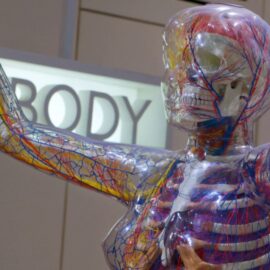

This article is an excerpt from the Shortform book guide to "The Tattooist of Auschwitz" by Heather Morris. Shortform has the world's best summaries and analyses of books you should be reading.
Like this article? Sign up for a free trial here .
How did Lale make his concentration camp escape? How did he jump out of the pot and into the fire?
In Heather Morris’ historical fiction novel, The Tattooist of Auschwitz, Lale escapes a concentration camp in Vienna. He ran into Russian soldiers who he thought might help him, but quickly realized he was forced into another dangerous situation.
Continue reading about Lale’s concentration camp escape.
Auschwitz Concentration Camp Escape
After the Auschwitz concentration camp escape, Lale is herded onto a train with many other prisoners. Lale’s train travels throughout the day. Like that first train ride back in 1942, he has no idea where he’s going. The train finally slows to a stop in front of Mauthausen, another concentration camp in Austria. Lale left most of his new bounty of treasures in his room, but he had managed to hide a few jewels.
The men at this camp seem worse off than those at Birkenau. They’re like walking skeletons. The guards are more relaxed at this camp and simply instruct the new arrivals to find a place to sleep for the night. It takes Lale four tries before he finds an empty bunk to call his own.
Morning comes, and Lale leaves his block to find a long line of naked men. He realizes they are going to be strip-searched, and his precious stones will be found. Quickly, he shoves three diamonds in his mouth and rushes back to the block to hide the rest. When the officers check the mouths of the men in front of Lale, he shoves the diamonds under his tongue and opens his mouth. When the guards get to Lale’s waiting mouth, they glance in and move on.
Looking for Work in Mauthausen Camp
Lale is at Mauthausen Camp for several weeks. He never would have believed that boredom would be his predominant emotion in a concentration camp, but after his busy life at Auschwitz, he languishes with nothing to do. He observes the guards to determine which one might make a good ally. He speaks German to one officer who walks by, and the two strike up a conversation. Lale tells this man all about Auschwitz, making it sound more like Disneyland than a camp. He doesn’t see the point in dredging up the horrible truth.
Days later, this same officer tells Lale that he can get him transferred to a different camp in Vienna where there might be work opportunities. The only catch is that they don’t accept Jews. He tells Lale to hide his tattoo and to give them his name at the truck. Lale almost doesn’t understand what he’s hearing. He hasn’t been anything but a number in so long, he has forgotten he could be addressed by his name. Lale gives the officer a diamond for his troubles.
Lale’s Concentration Camp Escape
In Vienna, the guards are even more lax than at Mauthausen Camp. They simply tell the prisoners to find a bunk and where to get their meals. Lale keeps to himself in this new camp, having nothing in common with the other prisoners. With an unoccupied mind, Lale can’t stop thinking about Gita. He knows that moving from camp to camp is going to make it harder to catch up to her, wherever she is.
One day, two men ask Lale if he was the tattooist at Auschwitz. Lale says he was and asks who wants to know. The men say they were just curious and move on, but a few minutes later, SS officers grab Lale and take him to see the commanding officer. They pull up his sleeve, revealing his tattoo. The commander asks if Lale is Jewish. Lale says that he’s Catholic, but the officer is dubious. He asks Lale twice more if he is Jewish, seeming ready to force the truth out of him. But the subject is quickly dropped when Lale starts to take off his pants to prove he is not a Jew.
After this visit, something changes inside Lale. He’s had enough of these interrogations and decides he won’t be a prisoner for one more day. He decides to make a concentration camp escape. He finds a weak spot in the fence at the back of the camp and crawls through. For the rest of the day and night, Lale walks through a forest. He hears and sees gunfire in front of him and moves closer, hoping it’s the Russians or Americans. But when he hears a shot only a few feet away, he jumps in the river and pretends to be a dead body floating by. Cold and exhausted, he climbs up onto the bank and collapses. He had no energy left after his concentration camp escape.
The next day, Lale makes it to a road overrun by Russian soldiers heading in one direction. He steps out from the forest, hoping to find help, but the Russians could care less about him. He decides to risk walking in the opposite direction in search of a town. Lale doesn’t get far before a jeep carrying a Russian official stops next to him. This man has never heard of Auschwitz and seems unfazed by Lale’s tattoo. What does interest him is Lale’s perfect Russian. After learning that Lale speaks five other languages, the official orders Lale into the jeep.
From Rags to Riches
The jeep pulls into a circular drive of a large chalet atop a hill, the wide Vienna countryside spread out below. Luxury vehicles are parked along the drive, and inside the chalet, the furnishings and artwork are exquisite. Lale can hardly handle the level of wealth and sophistication in this place compared with where he’s been for the last three years. He’s led into a large study, where a senior Russian officer sits behind a beautiful mahogany desk.
It doesn’t take long before Lale learns what his job will be. He is tasked with finding women in the village down the hill willing to party with the Russians. He’s taken to a large room with a four-poster bed, a private bathroom, a desk holding a Tiffany lamp, and a balcony with french doors. Of course, his first thought is that Gita would love it there, but he pushes the thought away. It hurts too much, and he’s not free to search for her yet.
Lale is shown a closet full of men’s clothing and told to find something nice that will fit him. Suits, dress shirts, polished dress shoes, and ties are neatly displayed in the closet. Lale runs his hands over the fine fabrics. In a drawer, he finds woolen socks and cotton underwear. A small spark lights up inside. This is the wardrobe of the old Lale. After picking out a suit for tomorrow, Lale runs a hot bath. He sits in it for a long time, replenishing the hot water once. This is his first bath in three years, and he soaks for as long as possible.
After the bath, a man named Friedrich enters Lale’s room. He will be Lale’s handler, and he has been ordered to shoot Lale if he tries to escape. He shows Lale a vault filled with cash and jewels, a much larger collection than Lale’s at camp. Lale will take cash and jewelry to entice the village women, and he can make whatever deal he wants. The money and jewelry are meticulously catalogued, and Lale must return whatever he doesn’t use at the end of the day.
Once his duties are explained, Lale is introduced to the chalet chefs. Friedrich tells him to ask for anything he wants, and it will be made. That night, Lale receives a dinner tray in his room. The meal consists of lamb in a rich sauce and carrots with butter and parsley. The food is rich and flavorful, but he struggles to enjoy it. Without knowing what has happened to Gita, the delectable meal is unsatisfying. He eats half and saves the rest, the way he did at camp.

———End of Preview———
Like what you just read? Read the rest of the world's best book summary and analysis of Heather Morris's "The Tattooist of Auschwitz" at Shortform .
Here's what you'll find in our full The Tattooist of Auschwitz summary :
- How a man used tattooing skills to stay alive at Auschwitz-Birkenau
- How Lale Sokolov fell in love in these unusual circumstances
- How Lale goes from concentration camp to Russian prisoner before finding freedom






